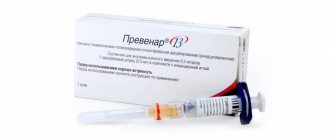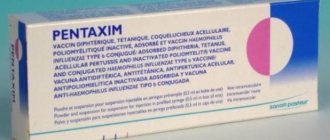Influenza vaccine (inactivated)
Used in children over 6 months, adolescents and adults. Manufacturer – Russia
Grippol® plus is an anti-influenza trivalent inactivated polymer-subunit vaccine. It is a protective antigen (hemagglutinin and neuraminidase) isolated from purified influenza viruses type A and B grown on chicken embryos, associated with a water-soluble high-molecular immunoadjuvant N-oxidized derivative of poly-1,4-ethylenepiperazine (azoximer bromide). The antigenic composition of the vaccine changes every year in accordance with the epidemic situation and WHO recommendations. The vaccine causes the formation of a high level of specific immunity against influenza. The protective effect after vaccination, as a rule, occurs after 8-12 days and lasts up to 12 months, incl. in elderly people. Protective titers of antibodies to influenza viruses after vaccination of people of different ages are determined in 75-95% of vaccinated people.
pharmachologic effect
Grippol® plus is an anti-influenza trivalent inactivated polymer-subunit vaccine. The antigenic composition of the vaccine changes every year in accordance with the epidemic situation and WHO recommendations. The vaccine causes the formation of a high level of specific immunity against influenza. The protective effect after vaccination, as a rule, occurs after 8-12 days and lasts up to 12 months, incl. in elderly people. Protective titers of antibodies to influenza viruses after vaccination of people of different ages are determined in 75-95% of vaccinated people. The inclusion of the immunomodulator azoximer bromide in the vaccine preparation ensures an increase in the immunogenicity and stability of antigens, increases immunological memory, significantly reduces the vaccination dose of antigens, and increases the body's resistance to other infections by correcting the immune status.
What is the difference between Sovigrippa and Grippol plus
Sovigripp is a domestic pharmaceutical product to combat viral infection. Applicable since 2013. The drug contains influenza strains of medium activity. Every year, the vaccine undergoes variability as a result of the antigenic mutation of the pathogen, which makes it possible to increase its effectiveness in eliminating pathogenic flora.
The active and auxiliary components are:
- Hemagglutinin of different types of virus.
- Thiomersal in combination with the mercury emblem.
- Sovidon.
- A buffer mixture containing sodium and potassium hydrogen phosphates, potassium dihydrogen phosphate and clean water.
The pharmacological agent is intended for parenteral administration into the muscle. This is the buttock, thigh or shoulder area.
Grippol Plus is a Russian liquid vaccine in the form of an injection solution. Refers to third generation vaccination drugs. Therefore, the active component of the product is the virus antigens, neutralized by chemical means. They rarely cause allergy symptoms.
The vaccine contains glycoproteins from several strains of influenza A and B types. Excipients are azoximer bromide and a phosphate-salt mixture. The vaccine is used for subcutaneous and intramuscular administration.
As for preservatives, they are used when dispensing large vials of the drug, which helps eliminate microbial contamination. Thus, Sovigrippa uses thiomersal with ethyl mercury, and the Grippol plus vaccine contains no chemical additives at all.
Indications
Specific prevention of influenza in children from 6 months of age, adolescents and adults without age restrictions . The vaccine is especially indicated for people at high risk of complications from influenza:
- over 60 years old, preschool children, schoolchildren;
- adults and children who often suffer from acute respiratory infections, suffering from chronic somatic diseases, incl. diseases and malformations of the central nervous system, cardiovascular system and bronchopulmonary system, bronchial asthma, chronic kidney disease, diabetes mellitus, metabolic diseases, autoimmune diseases, allergic diseases (except allergy to chicken protein), chronic anemia, congenital or acquired immunodeficiency , HIV-infected;
The vaccine is also indicated for persons whose profession has a high risk of contracting influenza or infecting others with it, including:
- health workers, employees of educational institutions, social services, transport, trade, police, and military personnel.
Grippol plus
The influenza vaccine “Grippol Plus” is a domestic vaccine, patented by the Institute of Immunology in 1995 and produced according to international GMP standards. Refers to the latest generation of inactivated polymer-subunit vaccines, which are characterized by safety and a low number of adverse reactions.
The vaccine contains antigens of 2 A-type viruses and one B-type antigen, as well as a substance that activates the body’s own immune response to fight viruses – polyoxidonium. The use of polyoxidonium allows the dose of antigens to be reduced threefold compared to other vaccines.
The Grippol Plus vaccine does not contain preservatives or antibiotics, internal virus antigens or toxic impurities in the form of lipids. The absence of preservatives is due to production conditions that comply with GMP standards, ensuring complete sterility through the use of an individual syringe dose.
The vaccine contains surface antigens of the virus, which ensure the appearance of antibodies on days 8-12, which last for almost a year.
Every year, the antigenic composition of Grippol Plus is updated in accordance with World Health Organization forecasts on the spread of the most dangerous strains of influenza viruses.
Purpose
Vaccination with Grippol Plus is recommended annually before the ARVI season.
The high safety and low reactogenicity of the vaccine allows us to recommend it for the prevention of influenza among various categories of citizens:
- children from 6 months, teenagers and adults;
- pregnant and lactating women;
- adults belonging to risk groups for severe influenza and ARVI;
- old people;
First of all, vaccination is necessary for people from risk groups who are in contact with a large number of people (medical workers, teachers, transport and service workers, students, military personnel), as well as people at high risk of developing severe forms of influenza and complications. People with heart diseases - coronary artery disease, hypertension, lung diseases - bronchial asthma, chronic bronchitis are exposed to this risk; diabetes mellitus, obesity.
Application
The flu vaccine "Grippol Plus" is available in the form of a ready-to-use injection suspension in an individual syringe dose and an atraumatic needle.
Intramuscular injection is carried out in compliance with the dosage and the period between administrations for different age groups - adults are recommended to administer one dose of the vaccine once, children from 6 months, depending on age and previous vaccination, may require 2 doses of the vaccine with an interval of 4 weeks.
The flu shot Grippol Plus can be administered simultaneously with other vaccines in the national schedule of preventive vaccinations. In this case, contraindications to each of the vaccines used must be taken into account.
Contraindications
Before vaccination, consultation with a doctor is required not only regarding the state of health before the Grippol plus vaccination, but also to identify possible contraindications:
- Individual intolerance to chicken egg whites, since the strains of viruses contained in the vaccine are grown on the proteins of chicken embryos;
- An allergic reaction (after a previous vaccination) to other components of the vaccine;
- Increased body temperature;
- The period of exacerbation of chronic diseases.
The price of the Grippol Plus vaccine at the Miracle Doctor clinic is similar to prices in other mid-price clinics. Before administering the vaccine, a consultation with a therapist or pediatrician is required, which is paid separately.
You can make an appointment for vaccination with our specialists by calling or visiting the clinic’s website.
Dosage regimen
Vaccination is carried out annually in the autumn-winter period.
- For children over 3 years of age, adolescents and adults, the vaccine is administered intramuscularly or deeply subcutaneously into the upper third of the outer surface of the shoulder (into the deltoid muscle), and for younger children - intramuscularly into the anterolateral surface of the thigh.
- Children aged 6 to 35 months inclusive are administered 0.25 ml twice with an interval of 4 weeks.
- For children over 36 months and adults, the vaccine is administered once in a dose of 0.5 ml.
- Children who have not previously had the flu and have not been vaccinated may receive the vaccine twice with an interval of 3-4 weeks.
Safety and side effects
Sovigripp and Grippol plus are the most effective and safest drugs on the Russian market. This property of vaccines is explained by the reduction in the pathogenic effects of influenza viruses due to chemical agents.
But despite this, vaccines can cause the following side effects:
- Signs of an influenza infection include fever, cough, runny nose and malaise.
- Headache.
- Allergic manifestations in the form of itching, rash and hyperemia.
- Formation of a limited infiltrate in the injection area.
- Gastrointestinal disorders.
Severe side effects occur less often. These are erythema nodosum, neuralgia and paresthesia.
Immunization is highly not recommended in case of individual intolerance to chicken protein, severe disease conditions and the appearance of undesirable symptoms after the first vaccination.
Drug interactions
Grippol® plus can be used simultaneously with inactivated and live vaccines of the National Preventive Vaccination Calendar (except for BCG and BCG-M) and inactivated vaccines of the preventive vaccination calendar for epidemic indications (except for rabies). The vaccine can be administered against the background of basic therapy for the underlying disease.
Come get vaccinated at VIRILIS. A full range of vaccines for children and adults, family vaccinations - at a special price!
Which vaccine is more effective against influenza?
The therapeutic effect of Grippol plus and Sovigrippa is no different.
According to the opinion of many doctors, most are inclined to choose Sovigrippa. This is due to the wide range of therapeutic effects and few side effects.
Laboratory studies confirm the full compliance of vaccines with medical requirements.
The therapeutic duration of the products does not differ. Antiviral activity is noted 2-3 days after vaccination. The protective properties of pharmaceuticals last up to 6-12 months.
The effectiveness of "Grippol"
The composition of “Grippol” provides for the presence of virus particles, upon recognizing which the immune system produces antibodies against them. By contacting the virus, they suppress its reproduction and eliminate the risk of developing the disease in a vaccinated child or adult.
The composition of antigens and their volume are selected in such a way as to eliminate negative effects on the body, but at the same time achieve the production of the required amount of antibodies. The composition of the drug is updated annually based on data on the most dangerous strains of the virus.
This is relevant because antibodies are only effective against the antigens they were created against. In addition, you need to take into account the fact that the influenza virus has many varieties and mutates very quickly. Vaccination provides protection against the most active orthomyxoviruses this year. If a person becomes infected by others, it will not be able to provide protection.
The price of Grippol is affordable, and the drug itself is highly effective. It reduces the antigenic load on the body through the use of a biodegradable adjuvant, soluble in water. Its presence in the composition ensures a good immune response and increases the safety of the vaccine.
Which is better - Grippol plus or Sovigripp
There is no particular difference between the Grippol Plus and Sovigripp vaccines. Taking into account all the above information, we can conclude that pharmacological agents have a similar composition and side effects.
Both drugs are made in Russia, have a high degree of purification and fully comply with medical criteria.
The cost of a single dose of Sovigrippa is 200-250 rubles. The price of Grippol Plus is 2 times higher for a similar dosage and equals 430 rubles.
According to reviews, patients prefer the Sovigripp vaccine, noting its high effectiveness. Comparing the two drugs, Grippol plus is somewhat inferior to Sovigripp in quality and price.
Why get vaccinated against flu?
The Grippol vaccine makes it possible to minimize the risk of contracting the flu.
It has a viral etiology, occurs in an acute form and affects the respiratory tract. Today, influenza epidemics are quite common, and, despite the fact that most often its symptoms go away on their own within seven days, there are often cases when it causes complications. Moreover: it can cause death, which is confirmed by data from the World Health Organization, according to which more than 500 thousand people die from it every year.
Since modern medicine does not have specific methods for treating influenza, the best option is preventive measures in the form of vaccinations. World practice has more than 60 years of successful use and confirms the good effectiveness of this method.
The instructions for "Grippol" provide for its annual use before the peak of incidence. Timely vaccination can reduce morbidity rates by two to three times, as well as reduce mortality rates among those at risk. Particularly good indicators are observed in children aged 6 months to 7 years.
Flu vaccination: difficulties of choice
Although vaccination against the influenza virus has already started, its relevance in November remains high. Those who want to protect themselves from a dangerous infection can still catch the last train if they administer the drug in the coming weeks. However, this year, adherents of influenza immunization have a problem of choice - imported Vaxigrip and Influvac have disappeared from access, and their place has been taken by domestic drugs, which some experts are skeptical about. Let's figure it out.
Production Features
First of all, it’s worth remembering once again what the flu vaccine is. The drug production process begins after the World Health Organization (WHO) publishes a list of strains of influenza viruses that will be distributed in the coming season. Armed with this information, manufacturers isolate three current strains of the H1N1, H3N2 and type B influenza viruses that circulate annually, inject them into a fertilized chicken egg, and grow the three-component preparation. It will contain surface proteins (antigens) of all three strains of the influenza virus - hemagglutinins. When they are administered, antibodies are formed in the body, which provide basic immunity against the virus.
Grippol® plus (Grippol® plus)
Manufacturer: NPO PETROVAX PHARM LLC (Russia)
susp. intramuscular and subcutaneous administration 0.5 ml/1 dose: syringes 1, 5 or 10 pcs., amp. 5 or 10 pcs., fl. 5 or 10 pcs. Reg. No.: LSR-006981/08
Clinical and pharmacological group:
Vaccine to prevent influenza
Release form, composition and packaging
Suspension for intramuscular and subcutaneous administration
in the form of a colorless or slightly opalescent liquid with a yellowish tint.
| 0.5 ml (1 dose) | |
| hemagglutinin and neuraminidase of the following viral strains*: | |
| A(H1 N1)** | 5 mcg GA*** |
| A(H3 N2)** | 5 mcg GA*** |
| B* | 5 mcg GA** |
| azoximer bromide (polyoxidonium®) | 500 mcg |
Excipients:
phosphate-saline buffer (potassium chloride, potassium dihydrogen phosphate, sodium hydrogen phosphate dihydrate, sodium chloride, water for liquid) up to 0.5 ml; does not contain preservative.
0.5 ml - disposable syringes (1) - contour cell packaging (1) - cardboard packs. 0.5 ml - disposable syringes (5) - contour cell packaging (1) - cardboard packs. 0.5 ml - disposable syringes (5) - contour cell packaging (2) - cardboard packs. 0.5 ml - disposable syringes (10) - contour cell packaging (1) - cardboard packs. 0.5 ml - ampoules (5) - contour cell packaging (1) - cardboard packs. 0.5 ml - ampoules (5) - contour cell packaging (2) - cardboard packs. 0.5 ml - ampoules (5) - cardboard packs. 0.5 ml - ampoules (10) - cardboard packs. 0.5 ml - bottles (5) - contour cell packaging (1) - cardboard packs. 0.5 ml - bottles (5) - contour cell packaging (2) - cardboard packs. 0.5 ml - bottles (5) - cardboard packs. 0.5 ml - bottles (10) - cardboard packs.
* — produced by ABBOTT BIOLOGICALS BV, the Netherlands
** —
after the name of the type the name of the strain is placed;
The strain composition is being brought into line with WHO recommendations for the current epidemic influenza season. *** -
hemagglutinin.
Description of the active components of the drug "Grippol® plus"
pharmachologic effect
Influenza vaccine.
Immunobiological properties
Causes the formation of a high level of specific immunity against influenza. The protective effect after vaccination, as a rule, occurs after 8-12 days and lasts up to 12 months, incl. and in elderly people. Protective titers of antibodies to influenza viruses after vaccination of people of different ages are determined in 75-95% of vaccinated people.
The inclusion in the vaccine preparation of the immunomodulator polyoxidonium (azoximer bromide), which has a wide spectrum of immunopharmacological effects, increases the immunogenicity and stability of antigens, increases immunological memory, significantly reduces the vaccination dose of antigens, and increases the body's resistance to other infections by correcting the immune status.
Indications
Specific prevention of influenza in children from 6 months of age, adolescents and adults without age restrictions.
The vaccine is especially indicated for people at high risk of complications from influenza:
- over 60 years old, preschool children, schoolchildren;
- adults and children who often suffer from acute respiratory infections, suffering from chronic somatic diseases, incl. diseases and malformations of the central nervous system, cardiovascular system and bronchopulmonary system, bronchial asthma, chronic kidney disease, diabetes mellitus, metabolic diseases, autoimmune diseases, allergic diseases (except allergies to chicken proteins), chronic anemia, congenital or acquired immunodeficiency , HIV-infected;
The vaccine is also indicated for persons whose profession has a high risk of contracting influenza or infecting others with it, including:
— health workers, employees of educational institutions, social services, transport, trade, police, military personnel, etc.
Dosage regimen
Vaccination is carried out annually in the autumn-winter period. Vaccination is possible at the beginning of an epidemic rise in the incidence of influenza.
Children over 3 years old, teenagers and adults
the vaccine is administered intramuscularly or deeply subcutaneously into the upper third of the outer surface of the shoulder (into the deltoid muscle),
for children aged 6 to 35 months
- intramuscularly into the anterolateral surface of the thigh.
Children aged 6 to 35 months inclusive
0.25 ml is administered twice with an interval of 3-4 weeks.
Children over 36 months and adults
the vaccine is administered once in a dose of 0.5 ml.
Children who have not previously had the flu and have not been vaccinated may receive the vaccine twice with an interval of 3-4 weeks.
Patients with immunodeficiency and receiving immunosuppressive therapy
it is possible to administer the vaccine twice, 0.5 ml each, with an interval of 3-4 weeks.
Rules for administering the vaccine
Before use, the vaccine should be kept at room temperature and shaken well. Remove the protective cap from the needle and remove air from the syringe by holding it in a vertical position with the needle up and slowly pressing the plunger.
To immunize children for whom the administration of 0.25 ml (1/2 dose) of the vaccine is indicated, it is necessary to remove half of the contents of the syringe by pressing the plunger to the special mark marked on the syringe body, or to the red mark on the edge of the label, and inject the remaining 0.25 ml.
Side effect
Local reactions:
rarely - pain, swelling, redness of the skin.
Systemic reactions:
in some cases - general malaise, headache, fever, mild rhinitis, sore throat (these reactions usually disappear on their own after 1-3 days); extremely rarely (as with any other vaccination) - allergic reactions, myalgia, neuralgia, paresthesia, neurological disorders.
The vaccine is a highly purified drug and is well tolerated by adults and children. Local and general reactions to the vaccine are usually absent.
Contraindications
— allergic reactions to chicken protein and vaccine components;
- acute febrile conditions or exacerbation of a chronic disease (vaccination is carried out after recovery or during remission);
- persons who have previously experienced allergic reactions to influenza vaccines;
— for mild ARVI and acute intestinal diseases, vaccination is carried out after the temperature has normalized.
Pregnancy and lactation
Preclinical studies have shown that the inactivated polymer-subunit influenza vaccine does not have embryotoxic or teratogenic effects. The doctor makes the decision to vaccinate pregnant women individually, taking into account the risk of influenza infection and possible complications of influenza infection. Vaccination is safest in the second and third trimesters of pregnancy.
Breastfeeding is not a contraindication for vaccination.
Use in old age
Adults (no age limit)
prescribed 0.5 ml once.
Application for children
Children aged 3 years and older
prescribed 0.5 ml once.
special instructions
Do not administer i.v.
On the day of vaccination, a medical examination of the vaccinated person should be carried out with mandatory thermometry. At temperatures above 37°C, vaccination is not carried out.
The drug is not suitable for use in ampoules, vials, syringe doses with damaged integrity or labeling, if the physical properties (color, transparency) have changed, if the expiration date has expired, or if the requirements for storage conditions are violated.
In the rooms where vaccination is carried out, it is necessary to have anti-shock therapy. The vaccinated patient should be under the supervision of a health care professional for 30 minutes after immunization.
Overdose
There is no information about an overdose of the Grippol® plus vaccine.
Drug interactions
Grippol® plus can be used simultaneously with inactivated and live vaccines of the National Preventive Vaccination Calendar (except for BCG and BCG-M) and inactivated vaccines of the preventive vaccination calendar for epidemic indications (except for rabies). In this case, contraindications to each of the vaccines used should be taken into account; drugs should be administered to different parts of the body with different syringes.
The vaccine can be administered against the background of basic therapy for the underlying disease. Vaccination in patients receiving immunosuppressive therapy (corticosteroids, cytotoxic drugs, radiotherapy) may be less effective.
Conditions for dispensing from pharmacies
The drug is available with a prescription.
Storage conditions and periods
The drug should be stored out of the reach of children, protected from light at a temperature of 2° to 8°C; do not freeze. The drug that has been frozen cannot be used. Shelf life: 1 year. A drug that has expired cannot be used.
Transportation by all types of covered transport in light-proof containers at temperatures from 2° to 8°C, in conditions that exclude freezing. Transportation is allowed at temperatures up to 25°C for 6 hours.
Drug interactions
Grippol® plus can be used simultaneously with inactivated and live vaccines of the National Preventive Vaccination Calendar (except for BCG and BCG-M) and inactivated vaccines of the preventive vaccination calendar for epidemic indications (except for rabies). In this case, contraindications to each of the vaccines used should be taken into account; drugs should be administered to different parts of the body with different syringes.
The vaccine can be administered against the background of basic therapy for the underlying disease. Vaccination in patients receiving immunosuppressive therapy (corticosteroids, cytotoxic drugs, radiotherapy) may be less effective.
Which vaccine is suitable for children?
Both one and the other vaccines are completely identical. Regular monitoring by Roszdravnadzor allows us to cast aside all doubts about their safety. Therefore, both products are ideal for immunizing children.
Every year, changes occur in the composition of medications, which improves their quality and effectiveness in preventing influenza.
Everyone needs to be vaccinated - children and adults. The drugs have no toxic effects, so immunization is not prohibited during pregnancy. It is impossible to fully judge the effectiveness of the vaccine. Experts recommend getting vaccinated every year to prevent infection and complications during a flu epidemic.




